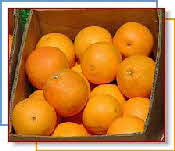Home | FOOD ARTICLES | Food Trivia | Today_in_Food_History | Food_History_Timeline | Recipes | Cooking_Tips | Food_Videos | Food_Quotes | Who’s_Who | Culinary_Schools_&_Tours | Food_Trivia_Quizzes | Food_Poems | Free_Magazines | Food_Festivals_and_Events
Food Articles, News & Features Section
FREE Magazines
and other Publications
Free Professional and Technical Research, White Papers, Case Studies, Magazines, and eBooks
See Also: History of Oranges; Orange Trivia; Orange Kitchen Tips
ORANGES: Selection, Storage, Use
Citrus fruit: Oranges are highly valued for their vitamin C content. It is a primary source of vitamin C for most Americans. This wonderful fruit has more to offer nutritionally than just this one nutrient, containing sufficient amounts of folacin, calcium, potassium, thiamin, niacin and magnesium. Most of the consumption of oranges is in the form of juice. Eating the whole fruit provides 130% of the recommended dietary allowance for vitamin C, less than the juice, but more fiber, which is not present in the juice.
The fruit is technically a hesperidium, a kind of berry. It consists of several easily separated carpels, or sections, each containing several seeds and many juice cells, covered by a leathery skin, containing numerous oil glands. Orange trees are evergreens, seldom exceeding 30 ft in height. The leaves are oval and glossy and the flowers are white and fragrant.
These semitropical evergreens probably originated in Southeast Asia. Columbus and other European travelers brought sweet orange seed and seedlings with them to the New World. By 1820 there were groves in St Augustine, Florida, and by the end of the Civil War oranges were being shipped north in groves. A freeze produced a major set back in production in 1895, but by 1910 crops in Florida had been reestablished. Florida is the number one citrus producer, producing 70% of the U.S. crop, with 90% of that going into juice. However, Arizona, Texas, and California also produce small amounts, with variations in color and peel. (Wellness Encyclopedia of Food and Nutrition, 1992).
 Selection
Selection
All varieties should be firm, heavy for size, and have fine-textured skin. Look for fruit that is firm and heavy for its size, with bright, colorful skins. Skin color is not a good guide to quality. Fruits may be ripe even though they may have green spots. Avoid fruit with bruised, wrinkled or discolored skins; this indicates the fruit is old or has been stored incorrectly. Citrus fruit peel may vary in thickness, depending on weather conditions during the growing season. Thinner skins tend to be juicier than thick skin fruits.
Storage
Oranges can be stored at room temperature, in the refrigerator without plastic bags or in the crisper drawer for up to 2 weeks. They do not ripen further after harvest. Fresh-squeezed juice and grated peel or zest may be refrigerated or frozen, but whole citrus fruit should not be frozen.
Oranges may exhibit some re-greening of the skin; this does not adversely affect internal fruit quality. Neither does surface scarring, which occurs when wind brushed young fruit against the tree.
Varieties
Varieties include the sweet orange, the sour orange, and the mandarin orange, or tangerine. The United States produces the sweet variety. Spain produces the sour variety, Seville, which is used in marmalades and liquers. Most all oranges have a yellow orange color with sizes ranging from small to large. The inside of an orange is plump and juicy. Sweet favorites include the Blood, Hamlin, Jaffa, Navel, Pineapple and Valencia. The color depends on the climate. Florida's warm days and nights produce oranges with some green in the skin coloring. California and Arizona oranges tend to have deeper orange color due to cooler desert nights.
The principal varieties of the sweet orange cultivated by orange growers of the eastern United States are the Hamlin and Parson Brown, both early-maturing, seedy varieties with thin, russet skin and juicy pulp. Both eastern and western growers cultivate the Valencia, a late variety that is commercially seedless. Fresh oranges from California and Arizona are available throughout the year, with two major varieties, Navels and Valencias. The Moro orange (a type of blood orange) and the red Cara Navel are two western-grown seasonal varieties. The Navel orange is a seedless orange, with medium-thick rind, in which a second small, orange grows. A variety of the Washington Navel orange is the principal orange product of Texas.
- Drink a cool glass of orange juice for breakfast or serve orange halves instead of grapefruit for a change.
- Combine the juice with other fruits and yogurt in the blender for a smoothie any time of day.
- A couple of tablespoons of orange juice concentrate can be added to a fruit cup for a great flavorful sauce.
- Cut oranges into wedges and eat them for a light snack or use them as edible garnishes.
- Buy a zesting tool or grate orange rind to use in recipes, rice, or stir fry for added flavor.
- Carry an orange with you wherever you go, they come in their own covered container so you can just peel and eat orange segments whenever the snack craze occurs.
- Orange juice can be used over fresh fruits to prevent browning.
RELATED ARTICLES
Please feel free to link to any pages of FoodReference.com from your website.
For permission to use any of this content please E-mail: james@foodreference.com
All contents are copyright © 1990 - 2025 James T. Ehler and www.FoodReference.com unless otherwise noted. All rights reserved.
You may copy and use portions of this website for non-commercial, personal use only.
Any other use of these materials without prior written authorization is not very nice and violates the copyright.
Please take the time to request permission.


